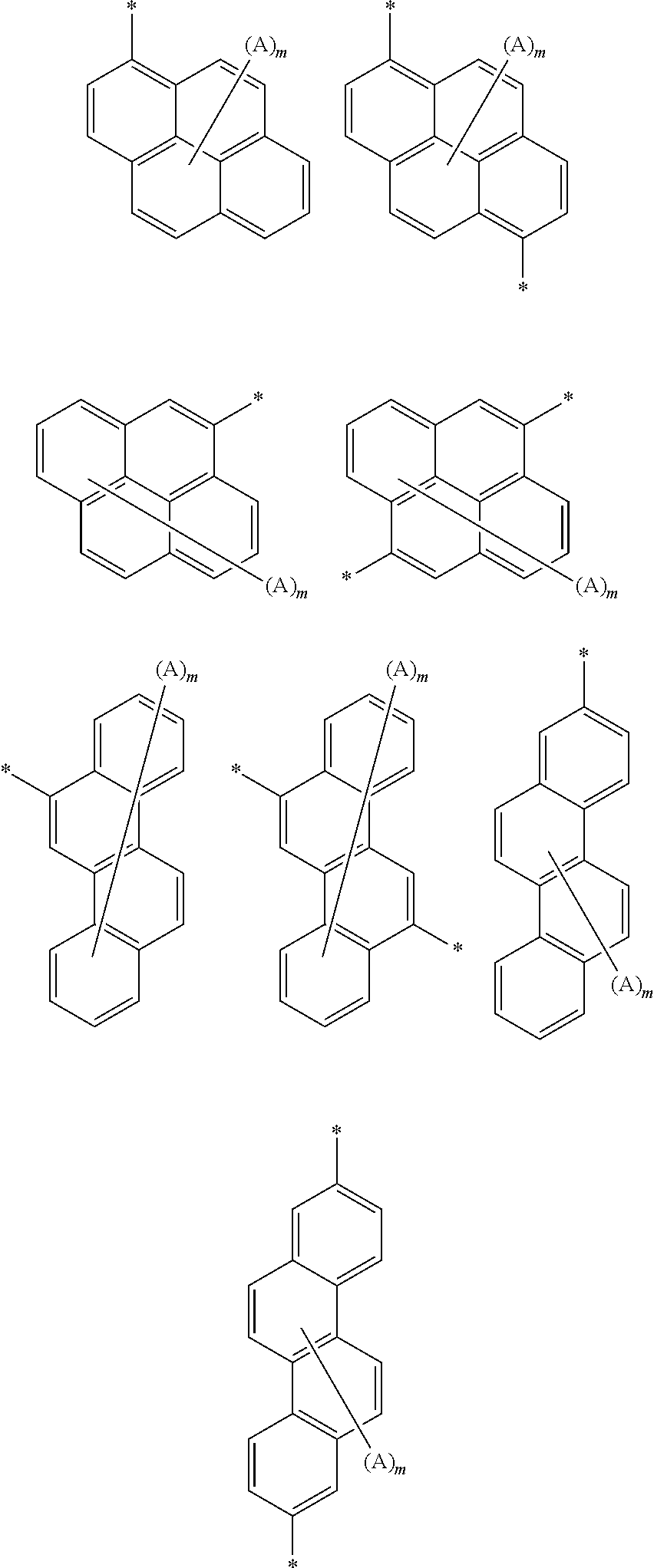Organic electroluminescent device comprising the organic electroluminescent compounds
a technology of electroluminescent devices and organic compounds, which is applied in the direction of organic chemistry, non-metal conductors, conductors, etc., can solve the problems of low luminescent efficiency, low current efficiency, and inability to provide high current efficiency and satisfactory operating lifespan, etc., to achieve high luminescent efficiency, long operating lifespan, and high brightness
- Summary
- Abstract
- Description
- Claims
- Application Information
AI Technical Summary
Benefits of technology
Problems solved by technology
Method used
Image
Examples
example 8
Preparation of Compound D-32
[0068]
[0069]1,6-dibromopyrene (10.0 g, 27.8 mmol), indoline (6.9 mL, 61.1 mmol), palladium acetate (318 mg, 1.4 mmol), tri-t-butyl phosphine (0.7 mL, 2.8 mmol) and cesium carbonate (27 g, 83.3 mmol) were dissolved in toluene. The reaction mixture was stirred for 24 hours at 120° C. under reflux. After completing the reaction, the organic layer was extracted with EA and was rinsed with distilled water. The obtained organic layer was dried over MgSO4 and was distilled under the reduced pressure. The organic layer was separated through column to obtain compound D-32 (5 g, Yield: 41%).
example 9
Preparation of Compound D-69
[0070]
[0071]Compound D-69 was prepared (3.2 g, Yield: 36%) in the same synthesis method as in the preparation of compound D-8 by using 6,12-dibromochrycene and diphenylamine.
[0072]Host compound Nos. C-1 to C-51 and dopant compound Nos. D-1 to D-77 for an organic electroluminescent device were prepared in the same method as in Examples 1 to 9. Yield (%), MS / EIMS, UV (nm) and PL (nm) of the prepared compounds are provided in the table 1 below:
TABLE 1CompoundMS / EIMSNos.Yiled(%)FoundCalculatedUV(nm)PL(nm)C-142456.6457.3395438C-2452462.3461.2D-830536.2536.6248, 299, 422469D-950586.2586.6317, 416446D-1040794.3795.0310, 426456D-1439622.2622.6D-1645608.2608.6D-1727738.2738.8246, 314, 416452D-1934732.3732.9340461D-2113.7635.2635.7D-2230916.3917246, 273, 317,565419D-2360818.3819.0243, 280, 332,476419D-2530635.2635.7250448D-2625672.2672.6240, 260, 303,453409D-2749.5890.3691.0248, 324, 409453D-2828756.3756.9D-2934465.2464.6354502D-3051976.4977.2D-3132886.4887.1D-3241...
example 1
Device Example 1
Production of an OLED Device Using the Organic Electroluminescent Compound According to the Present Invention
[0073]An OLED device was produced using the light-emitting material according to the present invention. A transparent electrode indium tin oxide (ITO) thin film (15 Ω / sq) on a glass substrate for an organic light-emitting diode (OLED) device (Samsung Corning, Republic of Korea) was subjected to an ultrasonic washing with trichloroethylene, acetone, ethanol and distilled water, sequentially, and then was stored in isopropanol. Then, the ITO substrate was mounted on a substrate holder of a vacuum vapor depositing apparatus. 4,4′,4″-tris(N,N-(2-naphthyl)-phenylamino)triphenylamine was introduced into a cell of said vacuum vapor depositing apparatus, and then the pressure in the chamber of said apparatus was controlled to 10−6 torr. Thereafter, an electric current was applied to the cell to evaporate said introduced material, thereby forming a hole injection layer...
PUM
| Property | Measurement | Unit |
|---|---|---|
| voltage | aaaaa | aaaaa |
| thickness | aaaaa | aaaaa |
| thickness | aaaaa | aaaaa |
Abstract
Description
Claims
Application Information
 Login to View More
Login to View More - R&D
- Intellectual Property
- Life Sciences
- Materials
- Tech Scout
- Unparalleled Data Quality
- Higher Quality Content
- 60% Fewer Hallucinations
Browse by: Latest US Patents, China's latest patents, Technical Efficacy Thesaurus, Application Domain, Technology Topic, Popular Technical Reports.
© 2025 PatSnap. All rights reserved.Legal|Privacy policy|Modern Slavery Act Transparency Statement|Sitemap|About US| Contact US: help@patsnap.com



